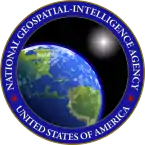National Geospatial-Intelligence Agency
The National Geospatial-Intelligence Agency (NGA) is a combat support agency under the United States Department of Defense and a member of the United States Intelligence Community,[8] with the primary mission of collecting, analyzing, and distributing geospatial intelligence (GEOINT) in support of national security. NGA was known as the National Imagery and Mapping Agency (NIMA) from 1996 to 2003.
 Seal of the U.S. National Geospatial-Intelligence Agency | |
 Flag of the U.S. National Geospatial-Intelligence Agency | |
 NGA Campus East, headquarters of the agency; the building features trapezoidal windows, color-coded interior sections, and is bisected by an atrium that is large enough to hold the Statue of Liberty[1][2][3] | |
| Agency overview | |
|---|---|
| Formed | October 1, 1996 (as the National Imagery and Mapping Agency) |
| Preceding agency |
|
| Jurisdiction | U.S. Department of Defense |
| Headquarters | Fort Belvoir, Virginia, U.S.[2] 38.7532°N 77.1969°W |
| Motto | "Know the Earth... Show the Way... Understand the World" |
| Employees | About 16,000[4] |
| Annual budget | Classified (at least $4.9 billion, as of 2013)[5] |
| Agency executives |
|
| Parent agency | Department of Defense |
| Website | www |
| Footnotes | |
| [7] | |
NGA headquarters, also known as NGA Campus East or NCE, is located at Fort Belvoir North Area in Springfield, Virginia. The agency also operates major facilities in the St. Louis, Missouri area (referred to as NGA Campus West or NCW), as well as support and liaison offices worldwide. The NGA headquarters, at 2.3 million square feet (214,000 m2), is the third-largest government building in the Washington metropolitan area after The Pentagon and the Ronald Reagan Building.[9]
In addition to using GEOINT for U.S. military and intelligence efforts, NGA provides assistance during natural and man-made disasters, and security planning for major events such as the Olympic Games.[10]
In September 2018, NGA researchers released a high resolution terrain map[11] (detail down to the size of a car, and less in some areas) of Antarctica, named the "Reference Elevation Model of Antarctica" (REMA).[12]
History
U.S. mapping and charting efforts remained relatively unchanged until World War I, when aerial photography became a major contributor to battlefield intelligence. Using stereo viewers, photo-interpreters reviewed thousands of images. Many of these were of the same target at different angles and times, giving rise to what became modern imagery analysis and mapmaking.
Engineer Reproduction Plant (ERP)
The Engineer Reproduction Plant was the Army Corps of Engineers's first attempt to centralize mapping production, printing, and distribution. It was located on the grounds of the Army War College in Washington, D.C. Previously, topographic mapping had largely been a function of individual field engineer units using field surveying techniques or copying existing or captured products. In addition, ERP assumed the "supervision and maintenance" of the War Department Map Collection, effective April 1, 1939.
Army Map Service (AMS) / U.S. Army Topographic Command (USATC)
With the advent of the Second World War aviation, field surveys began giving way to photogrammetry, photo interpretation, and geodesy. During wartime, it became increasingly possible to compile maps with minimal field work. Out of this emerged AMS, which absorbed the existing ERP in May 1942. It was located at the Dalecarlia Site (including buildings now named for John C. Frémont and Charles H. Ruth) on MacArthur Blvd., just outside Washington, D.C., in Montgomery County, Maryland, and adjacent to the Dalecarlia Reservoir. AMS was designated as an Engineer field activity, effective July 1, 1942, by General Order 22, OCE, June 19, 1942. The Army Map Service also combined many of the Army's remaining geographic intelligence organizations and the Engineer Technical Intelligence Division. AMS was redesignated the U.S. Army Topographic Command (USATC) on September 1, 1968, and continued as an independent organization until 1972, when it was merged into the new Defense Mapping Agency (DMA) and redesignated as the DMA Topographic Center (DMATC) (see below).
Aeronautical Chart Plant (ACP)
After the war, as airplane capacity and range improved, the need for charts grew. The Army Air Corps established its map unit, which was renamed ACP in 1943 and was located in St. Louis, Missouri. ACP was known as the U.S. Air Force Aeronautical Chart and Information Center (ACIC) from 1952 to 1972 (See DMAAC below).
National Photographic Interpretation Center (NPIC)

Shortly before leaving office in January 1961, President Dwight D. Eisenhower authorized the creation of the National Photographic Interpretation Center, a joint project of the CIA and US DoD. NPIC was a component of the CIA's Directorate of Science and Technology (DDS&T) and its primary function was imagery analysis.[13] NPIC became part of the National Imagery and Mapping Agency (now NGA) in 1996.[14]
Cuban Missile Crisis
NPIC first identified the Soviet Union's basing of missiles in Cuba in 1962. By exploiting images from U-2 overflights and film from canisters ejected by orbiting Corona (satellite)s,[15] NPIC analysts developed the information necessary to inform U.S. policymakers and influence operations during the Cuban Missile Crisis. Their analysis garnered worldwide attention when the Kennedy Administration declassified and made public a portion of the images depicting the Soviet missiles on Cuban soil; Adlai Stevenson presented the images to the United Nations Security Council on October 25, 1962.
Directors of NPIC
| Director | Term of office |
|---|---|
| Arthur C. Lundahl | May 1953 – July 1973 |
| John J. Hicks | July 1973 – May 1978 |
| Brigadier Gen. Rutledge P. Hazzard | June 1978 – February 1984 |
| Robert M. Huffstutler | Feb 1984 – Jan 1988 |
| Frank J. Ruocco | February 1988 – February 1991 |
| Leo A. Hazlewood | February 1991 – September 1993 |
| Nancy E. Bone | October 1993 – September 1996 |
Defense Mapping Agency (DMA)
The Defense Mapping Agency was created on January 1, 1972, to consolidate all U.S. military mapping activities. DMA's "birth certificate", DoD Directive 5105.40, resulted from a formerly classified Presidential directive, "Organization and Management of the U.S. Foreign Intelligence Community" (November 5, 1971), which directed the consolidation of mapping functions previously dispersed among the military services.[16] DMA became operational on July 1, 1972, pursuant to General Order 3, DMA (June 16, 1972). On October 1, 1996, DMA was folded into the National Imagery and Mapping Agency – which later became NGA.[17]
DMA was first headquartered at the United States Naval Observatory in Washington, D.C, then at Falls Church, Virginia. Its mostly civilian workforce was concentrated at production sites in Bethesda, Maryland, Northern Virginia, and St. Louis, Missouri. DMA was formed from the Mapping, Charting, and Geodesy Division, Defense Intelligence Agency (DIA), and from various mapping-related organizations of the military services.[18]
- DMA Hydrographic Center (DMAHC)
DMAHC was formed in 1972 when the Navy's Hydrographic Office split its two components: The charting component was attached to DMAHC, and the survey component moved to the Naval Oceanographic Office, Bay St. Louis, Mississippi, on the grounds of what is now the Stennis Space Center. DMAHC was responsible for creating terrestrial maps of coastal areas worldwide and hydrographic charts for DoD. DMAHC was initially located in Suitland, Maryland, but later relocated to Brookmont (Bethesda), Maryland.
- DMA Topographic Center (DMATC)
DMATC was located in Brookmont (Bethesda), Maryland. It was responsible for creating topographic maps worldwide for DoD. DMATC's location in Bethesda, Maryland is the former site of NGA's headquarters.
- DMA Hydrographic/Topographic Center (DMAHTC)

DMAHC and DMATC eventually merged to form DMAHTC, with offices in Brookmont (Bethesda), Maryland.
- DMA Aerospace Center (DMAAC)
DMAAC originated with the U.S. Air Force's Aeronautical Chart and Information Center (ACIC) and was located in St. Louis, Missouri.
National Imagery and Mapping Agency (NIMA)


NIMA was established on October 1, 1996, by the National Defense Authorization Act for Fiscal Year 1997.[19] The creation of NIMA followed more than a year of study, debate, and planning by the defense, intelligence, and policy-making communities (as well as the Congress) and continuing consultations with customer organizations. The creation of NIMA centralized responsibility for imagery and mapping.
NIMA combined the DMA, the Central Imagery Office (CIO), and the Defense Dissemination Program Office (DDPO) in their entirety, and the mission and functions of the NPIC. Also merged into NIMA were the imagery exploitation, dissemination, and processing elements of the Defense Intelligence Agency, National Reconnaissance Office, and the Defense Airborne Reconnaissance Office.
NIMA's creation was clouded by the natural reluctance of cultures to merge and the fear that their respective missions—mapping in support of defense activities versus intelligence production, principally in support of national policymakers—would be subordinated, each to the other.[20]
NGA

With the enactment of the National Defense Authorization Act for Fiscal Year 2004 on November 24, 2003,[21] NIMA was renamed NGA to better reflect its primary mission in the area of GEOINT.[22]
2005 BRAC and Impact on NGA
As a part of the 2005 Base Realignment and Closure (BRAC) process, all major Washington, D.C.-area NGA facilities, including those in Bethesda, Maryland; Reston, Virginia; and Washington, D.C., would be consolidated at a new facility at the Fort Belvoir proving grounds. This new facility, later known as NCE, houses several thousand people and is situated on the former Engineer Proving Ground site near Fort Belvoir. NGA facilities in St. Louis were not affected by the 2005 BRAC process.[23]
The cost of the new center, as of March 2009, was expected to be $2.4 billion. The center's campus is approximately 2,400,000 square feet (220,000 m2) and was completed in September 2011.[24]
Organization
Employees
NGA employs professionals in aeronautical analysis, cartography, geospatial analysis, imagery analysis, marine analysis, the physical sciences, geodesy, computer and telecommunication engineering, and photogrammetry, as well as those in the national security and law enforcement fields.
NIMA / NGA Directors
This table lists all Directors of the NIMA and NGA and their term of office.
| Term of Office | Director |
|---|---|
| 1996–1998 | Rear Admiral Joseph J. Dantone, US Navy, Acting Director |
| 1998–2001 | Lieutenant General James C. King, US Army |
| 2001–2006 | Lieutenant General James R. Clapper, USAF, Retired[note 1] |
| 2006–2010 | Vice Admiral (VADM) Robert B. Murrett, USN |
| 2010–2014 | Letitia Long |
| 2014–2019 | Robert Cardillo |
| 2019–Present | Vice Admiral Robert D. Sharp, USN |
- Although General Clapper preferred the use of his military rank, he was in fact a member of the Defense Intelligence Senior Executive Service (DISES) during his term as Director of NIMA / NGA, as he had retired from active duty as the director of DIA in 1995. Clapper was the first civilian to head NIMA / NGA.
On February 22, 2010, Secretary of Defense Robert Gates announced that Letitia Long would become director later that year, becoming the first woman to head one of the 16 Intelligence Community component agencies. Long was at the time deputy director of the DIA.[25] Long was sworn in on August 9, 2010 as NGA Director.[26]
Civilian, Department of Defense, and Intelligence Community activities
- Osama bin Laden compound raid: NGA was integral in helping the Department of Defense and the U.S. Intelligence Community pinpoint the compound in Abbotabad, Pakistan where Osama bin Laden hid for several years and to plan the raid that killed him.[27][28]
- 9/11 aftermath: After the September 11, 2001 attacks, NIMA partnered with the U.S. Geological Survey to survey the World Trade Center site and determine the extent of the destruction.[15]
- Keyhole investment: NGA contributed approximately 25% of In-Q-Tel's funding of Keyhole Inc, whose Earth-viewing software became Google Earth.[29]
- Hurricane Katrina: NGA supported Hurricane Katrina relief efforts by "providing geospatial information about the affected areas based on imagery from commercial and U.S. government satellites, and from airborne platforms, to the Federal Emergency Management Agency (FEMA) and other government agencies.[30] NGA's Earth website is a central source of these efforts.
- Microsoft partnership: Microsoft Corp. and NGA have signed a letter of understanding to advance the design and delivery of geospatial information applications to customers.[31] NGA will continue to use the Microsoft Virtual Earth platform (as it did for Katrina relief) to provide geospatial support for humanitarian, peacekeeping, and national-security efforts. Virtual Earth is a set of online mapping and search services that deliver imagery through an API.
- Google and GeoEye: In 2008 NGA partnered with Google and GeoEye. Google would be allowed to use GeoEye spy satellite imagery with reduced resolution for Google Earth.[29]
- Open source software on GitHub: April 2014 NGA became the first intelligence agency to open-source software on GitHub.[32] NGA Director Letitia Long talks about NGA's GitHub initiative and the first offering, GeoQ, at the GEOINT Symposium. Her comments start at 40 minutes and 40 seconds from her GEOINT 2014 conference speech.[33] NGA open sources software packages under their GitHub organizational account.[34]
Controversies
NIMA / NGA has been involved in several controversies.
- India tested a nuclear weapon in 1998 that reportedly took the United States by surprise. Due to budget cuts in defense spending after the end of the Cold War (see Peace dividend), the Intelligence Community was forced to reevaluate the allocation of its limited resources.[35]
- In 1999, NIMA supposedly provided NATO war-planners with incorrect maps which did not reflect that the Chinese Embassy in Belgrade had moved locations, which some have argued was the cause of the accidental NATO bombing of the Chinese embassy in Belgrade. The Central Intelligence Agency countered this criticism by saying this overstates the importance of the map itself in the analytic process. Maps of urban areas will be out-of-date the day after they are published, but what is important is having accurate databases.[36]
- On Jan. 17, 2013, the USS Guardian was grounded on the Tubbataha Reef in the southern Philippines. The Navy investigated the cause of the accident and determined NGA was not at fault—rather, that the ship's leadership team failed to adhere to prudent, safe, and sound navigation principles. The Navy relied solely on an inaccurate Digital Nautical Chart (DNC) during the planning and execution of the navigation plan and failed to appropriately cross-reference additional charts and utilize visual cues.[37]
- From 2013 to 2018, NGA designated the latitude and longitude coordinates of a private residence as a default location for Pretoria, South Africa, causing the digital-mapping website MaxMind to set it as the location of over one million IP addresses, which in turn caused people searching for missing phones and other electronics (as well as other people trying to track down IP addresses in Pretoria and police officers attempting to track criminals) to show up at the residence. The issue was eventually resolved following a private investigation and a request to both NGA and MaxMind that the default location be changed.[38]
Other
Credit Union (NCE)
Constellation Federal Credit Union (CFCU) was chartered in 1944 during the Army Map Service era. It continued to serve all successive legacy agencies' employees and their families with a “once a member, always a member” policy until CFCU merged into Northwest Federal Credit Union in March 2019.[39] [40]
In 2011, upon consolidating most Washington DC metro area NGA employees to NCE, the Belvoir Federal Credit Union (BFCU) became the on-site credit union serving NCE-based personnel. In 2016, BFCU merged with Pentagon Federal Credit Union.[41]
Credit Union (NCW)
Arsenal Credit Union (ACU) was founded in August 1948 as Aero Chart Credit Union, organized to serve employees of the Aeronautical Chart Plant (ACP), located at the St. Louis Arsenal. The name changed to ACU in 1952, a nod to the St. Louis site's Civil War-era use as an arsenal.[42][43]
Gallery
 NGA Headquarters
NGA Headquarters NGA headquarters' atrium
NGA headquarters' atrium Letitia Long, NGA Director, 2010–2014
Letitia Long, NGA Director, 2010–2014
See also
References
- "BRAC side effect: Greener buildings". May 13, 2011.
- "NGA Campus East Fact Sheet" (PDF). Archived from the original (PDF) on February 21, 2014.
- "Photo gallery: An alternative geography". projects.washingtonpost.com.
- Frequently Asked Questions (FAQs) Archived November 24, 2013, at the Wayback Machine. .nga.mil. Retrieved on July 21, 2013.
- Gellman, Barton; Greg Miller (August 29, 2013). "U.S. spy network's successes, failures and objectives detailed in 'black budget' summary". The Washington Post. Retrieved August 29, 2013.
- "Rear Adm. Robert Sharp USN confirmed as new NGA director". intelligencecommunitynews.com. December 28, 2018. Retrieved February 8, 2019.
- "GSP - GSP". www.esa.int.
- "10 U.S. Code § 441 - Establishment". LII / Legal Information Institute.
- Serbu, Jared (September 27, 2011). "Geospatial intelligence HQ is now DC's 3rd largest federal office building". Federal News Radio. Retrieved March 19, 2016.
- "About NGA". Archived from the original on October 6, 2014.
- "Reference Elevation Model of Antarctica – Polar Geospatial Center". www.pgc.umn.edu.
- Stirone, Shannon (September 7, 2018). "New Antarctica Map Is Like 'Putting on Glasses for the First Time and Seeing 20/20' – A high resolution terrain map of Earth's frozen continent will help researchers better track changes on the ice as the planet warms". The New York Times. Retrieved September 9, 2018.
- "Thirty ... and thriving". Central Intelligence Agency. December 1, 1991. p. 1ff. Archived from the original on March 8, 2012. Retrieved May 30, 2010.
- "Jan. 18, 1961: National Photographic Interpretation Center". www.nga.mil.
- NGA History Archived March 20, 2009, at the Wayback Machine, nga.mil
- Nixon, Richard (November 5, 1971). "Memorandum, Subject: Organization and Management of the U.S. Foreign Intelligence Community" (PDF). gwu.edu. Retrieved August 12, 2007.
- "Defense Mapping Agency". NGA.mil.
- U.S. National Archives. "Guide to Federal Records: Records of the Defense Mapping Agency (DMA)". National Archives and Records Administration (NARA). Retrieved August 12, 2007.
- "National Defense Authorization Act for Fiscal Year 1997" (PDF). September 23, 1996. Retrieved February 10, 2008.
- Report of the Independent Commission on NIMA - December 2000 Archived September 19, 2009, at the Wayback Machine, nga.mil
- "National Defense Authorization Act for Fiscal Year 2004" (PDF). November 24, 2003. Retrieved February 10, 2008., gpo.gov
- "NGA: September-October 2003 State of the Agency" (PDF). Archived from the original (PDF) on September 19, 2009.
- New Campus East Archived November 5, 2009, at the Wayback Machine, nga.mil
- Davenport, Christian, "Projects' Costs Are Rising", Washington Post, March 31, 2009, p. B4
- "Gates names first woman to head major intel agency". FederalTimes.com. February 23, 2010. Retrieved February 25, 2010.
Letitia Long, currently the Defense Intelligence Agency's deputy director, will take over NGA this summer, Gates said.
- "Woman takes charge of major intelligence agency for the first time". CNN. August 9, 2010. Retrieved August 11, 2010.
- Ambinder, Marc (May 5, 2011). "The Little-Known Agency That Helped Kill Bin Laden". The Atlantic Monthly.
- "Osama bin Laden Compound Raid". National Geospatial-Intelligence Agency. Retrieved July 27, 2017.
 This article incorporates text from this source, which is in the public domain.
This article incorporates text from this source, which is in the public domain. - "Oakland emails give another glimpse into the Google-Military-Surveillance Complex". PandoDaily. March 7, 2014.
- Geospatial Intelligence Aids Hurricane Recovery Efforts Archived September 19, 2009, at the Wayback Machine, nga.mil
- Microsoft and NGA Announce Strategic Alliance Archived June 17, 2006, at the Wayback Machine, microsoft.com
- NGA releases open source code on GitHub, FierceGovernmentIT, April 07, 2014
- "» GEOINT 2013* – Keynote Letitia A. Long - USGIF official video portal". web.archive.org. July 30, 2017.
- "National Geospatial-Intelligence Agency". GitHub.
- "Secretive map agency opens its doors", CNN.com, December 13, 2002
- DCI Statement on the Belgrade Chinese Embassy Bombing to a House Permanent Select Committee on Intelligence Open Hearing, 22 July 1999, CIA
- "USS Guardian Grounding Investigation Results Released". U.S. Navy. Retrieved June 20, 2013.
- Hill, Kashmir (January 9, 2019). "How Cartographers for the U.S. Military Inadvertently Created a House of Horrors in South Africa". Gizmodo. Retrieved January 10, 2019.
- "Constellation Federal Credit Union - Miscellaneous - CFCU to NCE". constellationfcu.org. Archived from the original on July 29, 2013. Retrieved December 3, 2012.
- "Northwest Federal completes Constellation Federal Credit Union merger". WTOP.com. July 5, 2019. Retrieved August 2, 2020.
- "PenFed Credit Union merging with Belvoir Federal". WTOP.com. March 31, 2016. Retrieved August 2, 2020.
- "Arsenal Credit Union - Arsenal Credit Union - Our Roots and Structure". Arsenalcu.org. Archived from the original on November 30, 2012. Retrieved November 27, 2012.
- ""Solving the Mystery of the Arsenal Guns" by Randy R. McGuire". civilwarstlouis.com. Retrieved November 27, 2012.
Further reading
- Ambinder, Marc (May 5, 2011). "The Little-Known Agency That Helped Kill Bin Laden". The Atlantic. Explains NGA's capabilities.
External links
 Media related to National Geospatial-Intelligence Agency at Wikimedia Commons
Media related to National Geospatial-Intelligence Agency at Wikimedia Commons- Official website
- GEOnet Names Server (GNS) - Database of foreign geographic feature names. Worldwide coverage excluding the United States and Antarctica, containing approximately 3.93 million features with 5.45 million names, and their coordinates
- Center for Geospatial Intelligence : University of Missouri - Columbia research center focused on GeoINT
- JP 2-03, Geospatial Intelligence Support to Joint Operations, 31 October 2012
- Commission Report on the National Imagery and Mapping Agency
- GeoIntelligence: A trade publication covering the uses of spatial technologies for national defense and homeland security by organizations such as NGA
- Ensor, David (December 13, 2002). "Secretive map agency opens its doors". CNN.
- DMA Receives Hammer Award, 26 January 1996
- Agency Provides More Than Just Maps
- The Center for Intelligence and Security Studies trains new analysts in Intelligence Analysis

